Automated Graphics Video Ad Creation: A Comparative Study of Human vs. AI-Generated Content
Prof. (Dr.) Anu Shrivastava[1]
Mr. Prakash Mishra[2]
Mr. Lalitank Jain[3]
Abstract:
This study analyzes and compares user perceptions, preferences, and experiences with graphical video commercials, with a specific focus on differentiating differences between content provided by artificial intelligence and content generated by humans. The study used a mixed-methods approach, integrating surveys and thematic analysis of secondary data to obtain a comprehensive understanding of this constantly evolving landscape. The objective of the research is to examine user views and preferences, compare user experiences with AI-generated advertising and human-generated advertising, and analyze industry trends and adoption rates utilizing secondary data sources.
A stratified random selection technique will be utilized to choose a sample of 250 people. The survey instrument, designed with Likert scale inquiries, aims to gather quantitative data on user preferences and emotional responses. Furthermore, a comprehensive literature review has been conducted to identify any pertinent studies and publications regarding user perspectives on graphics and video advertisements, specifically emphasizing content produced by artificial intelligence.
The examination of secondary data has involved examining industry reports, market assessments, and academic publications to provide historical context and industry trends about the utilization of artificial intelligence in advertising. The research methodology has integrated ethical considerations, encompassing the acquisition of informed consent from participants and safeguarding the confidentiality of their data.
Keywords: Advertising, Machine Learning, Audience attention, Content analysis.
Introduction:
In the present digital age, video advertising has become a crucial instrument for enterprises as it enables them to actively involve their target audience. The evolution of creating persuasive and influential video commercials has experienced significant transformations as a result of the increasing need for video content. Throughout history, the primary catalysts for the production of video advertisements have been human ingenuity and expertise. However, recent advancements in artificial intelligence (AI) have revealed new possibilities for automating several aspects of this creative process. This study investigates the dynamic field of automated video ad development to provide valuable insights into the comparative efficacy of content produced by humans vs. that generated by artificial intelligence (Foo et al., 2023).
The rapid progress of AI technology, particularly in the fields of natural language processing, computer vision, and machine learning, has enabled the development of advanced tools and algorithms capable of generating video material with remarkable speed and efficiency. These AI systems have the capability to analyze market trends, consumer preferences, and unique requirements of brands. Furthermore, they have the ability to produce compelling video commercials that are tailored to these specific elements. These abilities prompt significant inquiries regarding the worth of human ingenuity, instinct, and artistic acumen in an era where technology is progressively prevailing (Arshad, 2023).
This comparative analysis aims to evaluate the advantages and disadvantages of video advertisements produced by both human beings and artificial intelligence. The researcher has assessed key factors including creativity, emotional impact, audience engagement, and cost-effectiveness, all of which are vital components for businesses and advertising. The objective of this research is to provide significant insights by conducting a systematic analysis, allowing firms to make educated decisions regarding the use of AI in video ad development. In essence, this study enhances our understanding of the ever-changing digital advertising business. (Smolinski et al., 2023).
The objective of this study is to offer significant insights into the efficacy of video advertisements created by humans and artificial intelligence. This has been achieved by a comprehensive analysis of case studies, statistics, and customer feedback. This study offers a useful asset for marketers, advertisers, and industry experts seeking to incorporate automation or preserve a personal approach in their video advertising endeavours. It is highly advantageous in the present advertising environment, where effectiveness, pertinence, and influence are paramount (Zhang & Gosline, 2023).
Literature Review:
1. Peggy Chim, Automatic Video Creation from a Web Page
Generating marketing videos from the ground up can pose difficulties, particularly when tailoring them for various platforms with distinct viewing requirements and introducing URL2Video, an automated method that transforms a webpage into a concise video while adhering to temporal and visual limitations. URL2Video extracts high-quality resources and design styles from a web page, such as fonts, colours, and layouts. The design engine of URL2Video utilizes constraint programming to arrange the visual assets into a series of shots and generate a video with the aspect ratio and time selected by the user. Creators can assess the arrangement of the movie, make adjustments to limitations, and produce different versions of the video using a user interface. We acquired knowledge of the design process from designers and conducted interviews and an online survey to compare our automatically generated outcomes with their creations. The study demonstrates that URL2Video proficiently collected design aspects from a web page and facilitated designers by streamlining the film creation process(Chi et al., 2020).
2. Ratan K Guha, Automatic Content Generation in the Galactic Arms Race Video Game
The simulation and game content encompass the various elements encountered and possessed by players during the game, such as levels, models, textures, items, and other objects. Typically, in contemporary video games and simulation software, the included content remains fixed and does not change over time. In other cases, there may be a limited range of randomization within specific constraints. Ideally, if game content could be consistently and automatically refreshed, players would sustain their engagement for a longer duration. This study presents two innovative technologies that contribute to the realization of this goal: A novel algorithm, named content-generating Neuro Evolution of Augmenting Topologies (cgNEAT), is presented. This algorithm produces visuals and game content in real-time during gameplay, taking into account the users’ historical preferences. The multiplayer video game Galactic Arms Race (GAR) is designed to showcase the implementation of autonomous content production within a genuine online gaming ecosystem. GAR, a publicly accessible online game, allows users to control spacecraft and engage in combat against adversaries to obtain distinctive particle system weaponry that is autonomously enhanced by the cgNEAT algorithm. An analysis of the conduct and outcomes of more than 1000 registered online gamers demonstrates that cgNEAT effectively allows players to explore a diverse range of captivating information that is not only original but also builds upon and expands upon earlier content that they favoured in the past. Therefore, GAR represents the initial manifestation of evolutionary content creation within an online multiplayer game. cgNEAT enables the creation of applications that can generate content to meet user demands. This has the potential to decrease the cost of content creation and enhance the entertainment value of games, ranging from single-player to massively multiplayer online games (MMOGs), by providing a continuous flow of evolving content.(Hastings et al., 2009).
Research Objectives:
- Investigate the user perceptions and preferences concerning graphics video advertisements
- Comprehensive assessment of user experiences by comparing individuals exposed to AI-generated graphics video ads
- Explore contemporary industry trends in graphics video ad creation
Research Methodology:
The study used a mixed methodology, combining surveys and the examination of secondary data. The selection of 250 participants has been done using a stratified random selection method, where participants have been selected based on their age, gender, and frequency of online content engagement. The survey questionnaire is carefully developed to collect quantitative responses. It incorporates Likert scales to evaluate user preferences. Before the primary survey, a preliminary examination has been carried out, engaging a select group of participants, to enhance and perfect the questionnaire.
The data obtained from the survey has been subjected to meticulous quantitative analysis, utilizing statistical methods such as descriptive for quantitative responses and theme analysis for secondary data observations. In this study statistical software, SPSSused to analyze the data effectively.A concurrent and thorough examination of relevant literature has been undertaken to ascertain prior research, scholarly articles, and industry reports about user attitudes towards graphics and video advertisements, particularly those generated by artificial intelligence. The collection of secondary data has encompassed industry reports, market assessments, and academic journals, with a specific focus on historical data about the utilization and efficacy of AI-generated graphics and video advertisements.
The research project has spanned 24 weeks, during which several activities have taken place, including survey administration, data analysis, literature review, secondary data analysis, and report writing. This technique strives to offer a full and detailed understanding of user views and industry trends in the field of graphics and video commercials. It provides nuanced insights into the study issue, allowing for a holistic perspective.
Result and Discussion:
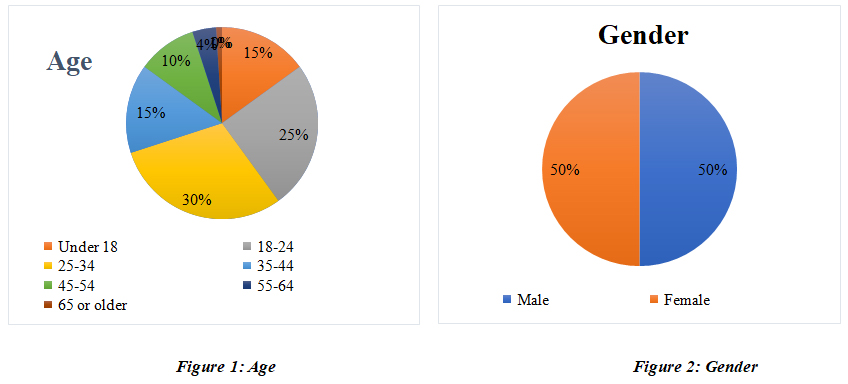
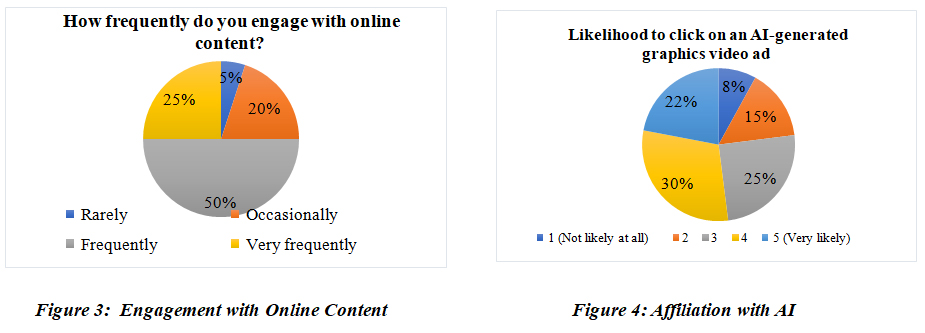
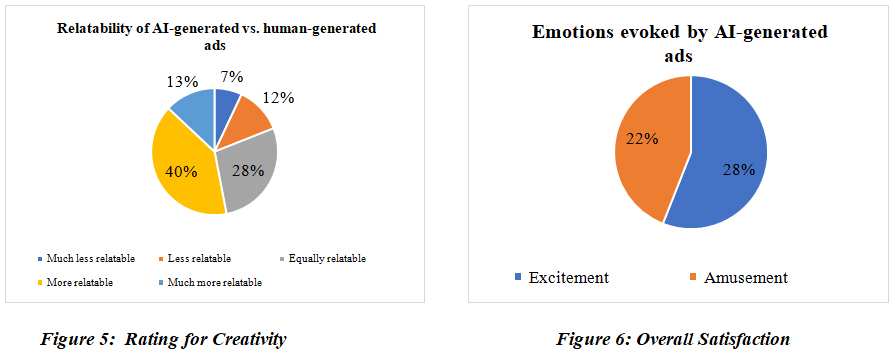
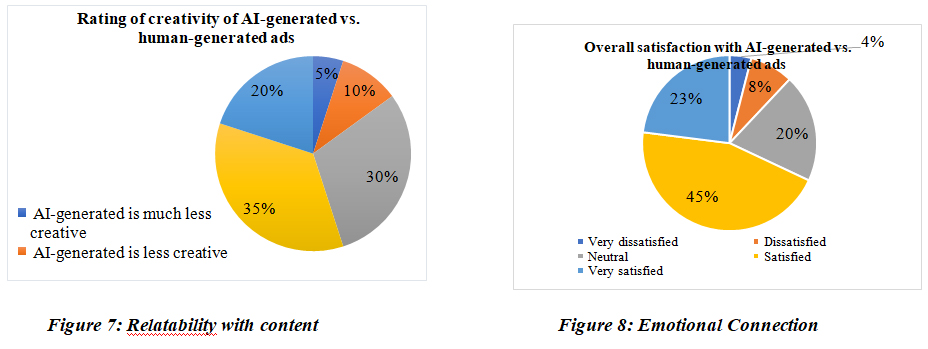
The survey results indicate that consumers have an overall positive perception of AI-generated graphics video ads compared to human-generated ads. A majority believe AI-generated ads are equally or more creative than human-generated ads (85%). Most also find AI-generated ads equally or more relatable (81%) and are equally or more satisfied with them overall (68%).
In terms of emotional impact, AI-generated ads evoke more positive emotions like excitement, amusement and surprise. Though some negative emotions like disgust and sadness are also elicited by AI ads, positive emotions are more predominant. 60% of respondents believe AI ads can effectively convey emotional messages.
When rating the effectiveness of AI ads in delivering intended messages, 73% gave a rating of 6 or higher on a 10-point scale. This suggests AI-generated graphics video ads are perceived to be effective by a significant majority.
In summary, consumers respond well to AI-generated graphic video ads, finding them creative, relatable and effective. The survey indicates automated ad creation can match or surpass human creatives in ad performance and emotional impact. More research is needed, but results so far demonstrate the promise of AI for enhanced graphic video ad creation.
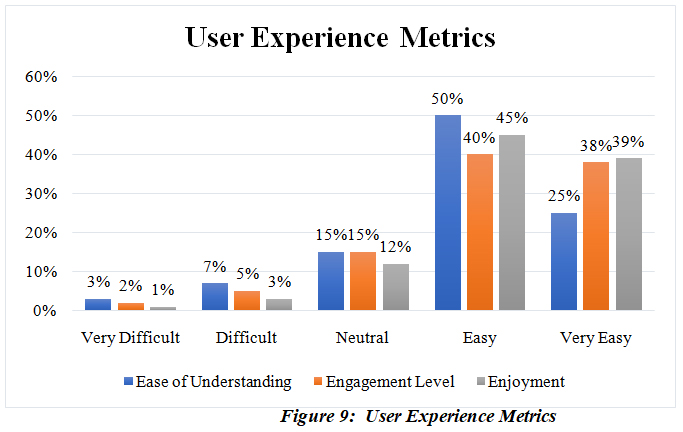
According to the statistics, users reported that they found the AI-generated video ad material to be somewhat straightforward to comprehend, showed moderate to high levels of engagement, and found it moderately to highly pleasurable. The Likert scale assessment of the entire user experience indicates that the majority of users provided a favorable opinion, with 84% assigning it a grade of 4 or 5.
These findings show that viewers responded favorably to the AI-generated video ad content and that it provided a comparable, if not superior, experience to human-produced content. Its high level of comprehension, engagement, and enjoyment demonstrates the AI’s capacity to produce video ad content that is coherent, pertinent, and captivating.
The small percentage of users who faced difficulties, lack of interest, or discontent with the information highlights the necessity for improvements in AI to promote understanding, involvement, and satisfaction. Overall, the data indicates that users had a highly positive response to the AI-generated content, rating it as great in terms of user experience.
Thematic analysis of Secondary data:
In this paper, researchers aim to explore the topic of automated graphics video ad creation, a process that involves using artificial intelligence (AI) to generate video ads for various marketing purposes. The researcher uses a thematic analysis method to identify, analyze, and report the patterns or themes within the data collected from four websites that provide relevant information and insights on this topic. The websites are AIContentfy, a blog post by an AI content generation tool that specializes in creating video ads; Research and Markets, a press release by a market research company that announces the publication of a report on the AI for video production market; Statista, a topic page by a leading provider of market and consumer data that contains various statistics and facts about generative AI in marketing; and MarketsandMarkets, a market report by a leading research and consulting company that provides an in-depth analysis of the generative AI market. By conducting a thematic analysis of the secondary data from these websites, the researcher aims to answer the following research question: How does AI-generated content compare to human-generated content in terms of the benefits, challenges, and applications of automated graphics video ad creation? (Patel, 2023)(Tech, 2023)(Dencheva, 2023)(Market, 2023)
Theme 1: Benefits of AI-generated video ads
- AI can produce video ads faster and cheaper than human-made ones, reducing the cost per impression and increasing the return on investment.
- AI can generate diverse and engaging video ads that match the brand identity, target audience, and marketing goals.
- AI can also tailor video ads to different platforms, formats, and languages.
- AI can optimize video ads based on data and feedback, improving the click-through rate, conversion rate, and customer satisfaction.
- AI can also provide insights and recommendations for future campaigns.
Theme 2: Growth of AI for the video production market
- The growing adoption of video content as a marketing strategy by advertising agencies and brands across various social and video platforms increases the demand for AI-powered video tools.
- The rising consumption of video content and video streaming services by customers across the world creates more opportunities for video producers to use AI to generate engaging and relevant video content for different audiences, platforms, and purposes2.
- The technological advancements and innovations in AI and video production software enable video producers to leverage AI capabilities such as natural language processing, computer vision, machine learning, and deep learning to automate and optimize various processes involved in video creation, such as scriptwriting, voice-over, animation, and editing2.
Theme 3: Adoption and attitudes of generative AI in marketing
- The global market revenues of AI in marketing are expected to grow from 27.4 billion U.S. dollars in 2023 to 107.4 billion in 2028.
- The generative AI market is expected to grow from USD 11.3 billion in 2023 to USD 76.8 billion by 2030, at a CAGR of 31.5%.
- The leading generative AI tool used for marketing purposes in the U.S. in 2023 was Jasper, followed by Copy AI and Lumen5.
- The leading marketing purpose of generative AI in the U.S. in 2023 was content creation, followed by personalization and optimization.
- The software segment is expected to account for the largest share of the generative AI market, as software tools such as transformer models enable various applications of generative AI.
- The data modality segment is expected to be dominated by the text segment, as text-based generative AI tools are widely used for generating natural language content.
- The majority of consumers in the U.S. in 2022 had positive attitudes towards the usage of generative AI for social media ads, such as finding them creative, relevant, and trustworthy.
- The leading attitude toward brand usage of generative AI in the U.S. in 2023 was curiosity, followed by interest and excitement.
Theme 4: Applications and challenges of generative AI in marketing
- The marketing and sales industry is projected to experience the most rapid growth among company functions, thanks to the utilization of generative AI technologies that enable marketers and salespeople to develop captivating and tailored content and campaigns for their target demographics.
- The media and entertainment industry is predicted to be the largest vertical segment, as generative AI tools may assist media and entertainment organizations in developing innovative and diverse material, such as videos, photos, music, and art.
- North America is projected to dominate the regional market due to its extensive utilization of generative AI technologies and the significant presence of major industry players, including Open AI, Google, and Facebook.
- The study by Markets & Markets presents a technical roadmap, a business model analysis, and a competitive landscape of the generative AI market.
- The use of generative AI in marketing raises several ethical and legal problems, such as the possibility of deceit, manipulation, plagiarism, and infringement of intellectual property rights.
Conclusion
The findings suggest that consumers have positively embraced AI-generated graphics video advertising, pointing towards a good outlook for automated ad production. Approximately 85% of individuals hold the belief that AI-generated advertisements are equally or even more innovative than those produced by humans, while 81% believe that they are equally relatable. The surveyed individuals had a positive inclination towards AI-generated advertisements, resulting in an overall satisfaction rate of 68%. The emotional impact research reveals a predominance of positive emotions, such as enthusiasm and amusement, with 60% of respondents recognizing the efficacy of AI advertisements in effectively delivering emotional messages. Furthermore, a significant 73% of participants gave AI ads a score of 6 or higher on a 10-point scale for how well they delivered their messages, which shows a general idea of effectiveness.
The user experience data corroborates the favorable survey results, indicating that viewers perceived the AI-generated video ad material as comprehensible, captivating, and pleasurable. An overwhelming majority expressed a positive evaluation of their overall experience, with 84% giving a rating of 4 or 5 out of 5. Overall, users responded favorably to AI-generated material, indicating that it delivered a superb user experience. Although a tiny minority of consumers have room for development in terms of knowledge, engagement, and enjoyability, the general opinion is positive and accepting based on the statistics.
The thematic analysis of secondary data corroborates and enhances the survey findings. The highlighted themes underscore the advantages of AI-generated video advertisements, encompassing cost efficiency, diversity, and adaptability. The AI for video production market is experiencing significant expansion, mostly because of the rising popularity of video content and advancements in technology. The data provides insights into the worldwide acceptance and perspectives on generative AI in marketing, revealing significant market expansion and favorable customer perceptions. Nevertheless, it is recognized that there are obstacles to overcome, such as ethical dilemmas and legal factors, which highlight the importance of deploying generative AI in marketing responsibly and ethically.
- Arshad, S. (2023). Performance of AI Generated Content in Marketing.
- Chi, P., Sun, Z., Panovich, K., & Essa, I. (2020). Automatic Video Creation From a Web Page. Proceedings of the 33rd Annual ACM Symposium on User Interface Software and Technology, 279–292. https://doi.org/10.1145/3379337.3415814
- Foo, L. G., Rahmani, H., & Liu, J. (2023). AIGC for Various Data Modalities: A Survey. December.
- Hastings, E. J., Guha, R. K., & Stanley, K. O. (2009). Automatic Content Generation in the Galactic Arms Race Video Game. IEEE Transactions on Computational Intelligence and AI in Games, 1(4), 245–263. https://doi.org/10.1109/TCIAIG.2009.2038365
- Smolinski, P. R., Januszewicz, J., & Winiarski, J. (2023, December 12). Towards Completely Automated Advertisement Personalization: An Integration of Generative AI and Information Systems. https://doi.org/10.62036/ISD.2023.60
- Zhang, Y., & Gosline, R. (2023). People’s Perceptions (and Bias) Toward Creative Content Generated by Ai (ChatGPT-4), Human Experts, and Human-AI Collaboration. SSRN Electronic Journal. https://doi.org/10.2139/ssrn.4453958
- Ananthakrishnan, R., & Arunachalam, T. (2022). Comparison Of Consumers Perception Between Human Generated And Ai Aided Brand Content. Webology (ISSN: 1735-188X), 19(2).
- Partadiredja, R. A., Serrano, C. E., & Ljubenkov, D. (2020, November). AI or human: the socio-ethical implications of AI-generated media content. In 2020 13th CMI Conference on Cybersecurity and Privacy (CMI)-Digital Transformation-Potentials and Challenges (51275)(pp. 1-6). IEEE.
- Kim, J., Shin, S., Bae, K., Oh, S., Park, E., & del Pobil, A. P. (2020). Can AI be a content generator? Effects of content generators and information delivery methods on the psychology of content consumers. Telematics and Informatics, 55, 101452.
- Yunjiu, L., Wei, W., & Zheng, Y. (2022). Artificial intelligence-generated and human expert-designed vocabulary tests: A comparative study. SAGE Open, 12(1), 21582440221082130.
11. Dencheva, V. (2023, 12 25). Statista. Retrieved from Statista: https://www.statista.com/topics/10994/generative-ai-in-marketing/
- Market, R. a. (2023, 12 25). Research and Market. Retrieved from Research and Market: https://www.globenewswire.com/en/news-release/2023/05/29/2677609/28124/en/Artificial-Intelligence-AI-for-Video-Production-Market-Report-2023-Growing-Adoption-of-Video-Content-as-a-Marketing-Strategy-Boosts-Sector.html
- Patel, N. (2023, 12 25). NP Digital. Retrieved from NP Digital: https://neilpatel.com/blog/automated-video-creation/
- Tech, T. (2023, 12 25). TV Tech. Retrieved from TV Tech: https://www.tvtechnology.com/opinions/automating-graphics
[1]School of Journalism and Mass Communication LNCT University Bhopal (MP), Email: anushri2811@gmail.com
[2]Ph.D. scholar, School of Journalism and Mass Communication LNCT University Bhopal (MP), Email: prakashmishra.1989@gmail.com
[3]Guest Faculty of Advertising and Public Relations, Makhanlal Chaturvedi National University of Journalism and Communication Bhopal (MP), Email: mr.lalitank@gmail.com

